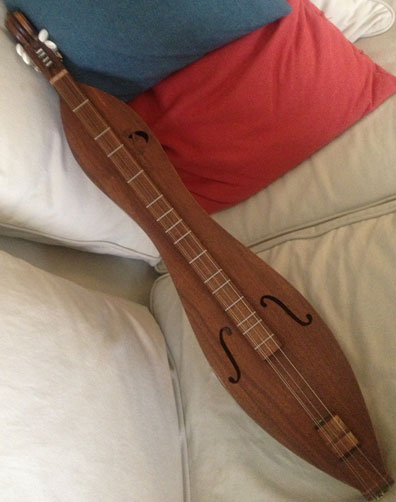Even in a relatively Podunk city like Albuquerque, it’s nearly impossible to throw a rock without getting taught to play “Stairway to Walgreens” on an out-of-tune Strat copy. Learning to play a musical instrument with an irritating degree of mediocrity can be one of the most satisfying accomplishments of your pitiful life, and it isn’t as difficult as you’d think. How much more ambitious, then, that I attempt mastery of an instrument I know nothing about? For over five decades I’ve practiced an intense and, I think, quite reasonable refusal to acknowledge the very existence of dulcimers. Yet dulcimers exist, if only in defiance of my will. Also, Cyndi Lauper plays the dulcimer, and I can do anything Lauper can. Anything.Finding a dulcimer in Albuquerque isn’t tricky, but there aren’t many options. Most musical instrument retailers will refer you to Apple Mountain Music at Morris and Comanche. Otherwise, you could maybe find a free dulcimer in an unlocked car at a Celtic Festival, but that’s a long shot. Apple Mountain Music hosts an inspiring menagerie of dulcimers, harps, melodicas, banjos and other weird, down-homey instruments beyond the ken of city-folk. Their dulcimers generally run for $300 and up, but I managed to get a used, home-crafted unit for only $100. My dulcimer features a hand-etched glyph of a turtle playing a flute (Kokopelli), much like my tuba, which is engraved with a giraffe playing bongo drums. My dulcimer also has bad intonation, which Apple Mountain Music owner Debra Fortess warned me about. That means the one-octave harmonic (exactly halfway across the string) sounds a little off from the note produced at one-octave fretted. When that’s the case, a fretted instrument will never sound in tune with itself up the neck. I’ve played dicey instruments before, but I wasn’t prepared for the profound effect bad intonation could have on a non-chromatic axe—and its fixed, glued wooden bridge leads me to believe it’s terminal.For a bit of background, there are two kinds of dulcimers and the name dulcimer is the only thing they share in common. One type, the hammer dulcimer, is a complicated device best left to the clergy. The other type—the Appalachian or "mountain" dulcimer, and the subject of this journalistic odyssey—is a simple stringed instrument developed by early American settlers suffering under such extreme, primitive and drunken conditions that it was "too hard" to build violins. Ben Franklin wasn’t involved, and they set the bar low.The mountain dulcimer looks like a wooden fish with a squish mark, or a hillbilly apple-jack violin whatchamacallit. It has four strings: two of them are closely spaced and tuned to D in unison; the other two are tuned in fifths to A and D, so it’s kind of like a punk-rock power chord on squirrel meat. As if that weren’t limiting enough, the frets are spaced according to a diatonic rather than chromatic scale. The term "diatonic" may sound ominous, but it actually forecasts melodies only so sinister as happy, white-key hits like "Mary Had a Little Lamb."Or so I thought. A quick exchange with Burque dulcimer guru Irma Reeder opened my eyes and ears to a world of dulcimer gymnastics that my half-hour of dulcimer noodling never hinted at. It’s amazing what a mountain dulcimer can do in the hands of masters like Stephen Siefert, Bing Futch, Janita Baker and Larry Conger. Reeder is the director of the New Mexico Dulcimer Festival, which has been bringing performances from dulcimer heavy-weights like these to Albuquerque since 2010. She also thinks she can fix the intonation on Storm Bringer (for thusly have I named now my dulcimer.)I admit in shame that I was unable to master this fish-like stringed instrument in five days, nor apparently even understand the scope of the undertaking. And maybe Cyndi Lauper can lay green speckled eggs while mine only come out brown. The point is I tried, and I know more now than I did before. Storm Bringer bids ye good day.
Apple Mountain Music10301 Comanche NE, Albuquerque, New Mexico 87111(505) 237-2048applemtnmusic.com


